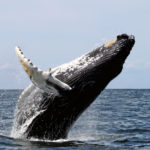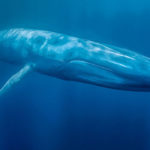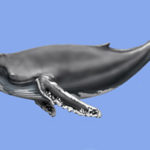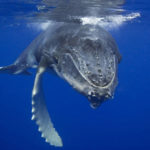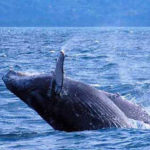Sperm whales
 Sperm whale is the largest of toothy whales. Length of males up to 20 m, weigh up to 50-70 t; Females are noticeably smaller – up to 13 m, weigh up to 30 tons. The shape of the body is drop-shaped. This is one of the most cosmopolitan animals that occurs in the world’s oceans from the Arctic waters to the equator. However, sperm whales rarely go beyond the subtropical zone, while males perform long seasonal migrations, in the summer reaching: in the north – the Davis Strait, the Barents and Bering seas, in the south – the Antarctic.
Sperm whale is the largest of toothy whales. Length of males up to 20 m, weigh up to 50-70 t; Females are noticeably smaller – up to 13 m, weigh up to 30 tons. The shape of the body is drop-shaped. This is one of the most cosmopolitan animals that occurs in the world’s oceans from the Arctic waters to the equator. However, sperm whales rarely go beyond the subtropical zone, while males perform long seasonal migrations, in the summer reaching: in the north – the Davis Strait, the Barents and Bering seas, in the south – the Antarctic.
Sperm whales have a huge head, disproportionate to the body, which reaches 1/3 of the entire length. On the head of the animal is a massive pillow weighing up to 6 tons of sperm. Scientists suggest that it serves as an echosounder, although there is another version, which says that this pillow performs a function similar to a swim bladder.
Although the sperm whale has teeth (up to 30 pairs, each weighing 1 kg.), They practically do not need it. The structure of the muzzle is such that it allows you to actively suck prey without using teeth. The lower jaw is very narrow, shorter than the muzzle, able to descend 90 degrees. This allows sperm whales to pick up from the bottom of crabs, crayfish and even stones that they need to grind food in the stomach. But still the lion’s share of the diet of sperm whales is formed by cephalopods: squid and octopus.
Famous known scars and traces of suckers on the body of sperm whales arise from fights with giant squid, reaching 10 meters in length. The confrontation of sperm whales and squids entered the legend: monstrous squids, protecting themselves from the sperm whale, leave traces of their suckers in the form of dented circles up to 20 cm in diameter. Once in the Antarctic, a live squid weighing 200 kg was removed from the stomach of a forty-sounder sperm whale. The tentacles of this mollusk protruded from the mouth of the sperm whale, snuggling tightly to his head.
Some scientists suggest that when hunting large squid, the sperm whale uses a directed high-frequency sound as a weapon, which leads the shellfish into confusion and disorientates it in space. Such a lost squid becomes an easy prey for the sperm whale.
It is believed that the beak of squid eaten irritates the intestine of the sperm whale, which entails the appearance of ambergris – a special odorous substance used in perfumery. In the rectum of a sperm whale caught in the Antarctic, a piece of amber with a mass of 420 kg was found.
Very interesting is the fact that squid, living in the upper layers of water, have no significance in feeding sperm whales, and cuttlefish living near the surface are generally ignored by these animals. For the squid sperm whale dives to a depth of at least 400 meters. Scientists believe that at such a depth, he does not have food competitors.
Just as the blue whales of the sperm whale actively use sounds when communicating, issuing short and frequent clicks, moaning squeaks and frequent crackling. But unlike blue whales, sperm whales are not such a loner, and can gather in flocks of up to 100 individuals. Only during the breeding season, males can leave the flock and live alone, and the rest of the time the male moves along with 10-15 females. Sperm whales are polygamous, sexual dimorphism in size is pronounced in them.
Female sperm whales usually do not go beyond the limits of warm and temperate waters, so the mating and reproduction period is not as severe in them as in those species whose females make regular migrations to the cold waters of both hemispheres. Generations of sperm whales come throughout the year, but the largest number of females bring offspring yet in a relatively short time. Apparently, for the Northern Hemisphere, this occurs in the early spring.







